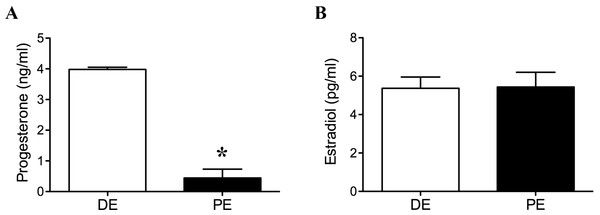
Recent work has led to the hypothesis that kisspeptin/neurokinin B/dynorphin (KNDy) neurons in the arcuate nucleus (ARC) play a key role in gonadotropin-releasing hormone (GnRH) pulse generation and gonadal steroid feedback, with kisspeptin driving GnRH release and neurokinin B and dynorphin acting as pulse start and stop signals, respectively. A separate cell group, expressing RFamide-related peptide-3 (RFRP-3) has been shown to be a primary inhibitor of GnRH release. Very little is known regarding these cell groups in the bovine. In this study, we examined the relative immunoreactivity of kisspeptin, dynorphin, and RFRP-3 and their possible connectivity to GnRH neurons in the hypothalami of periestrus and diestrus bovine. While GnRH and RFRP-3 immunoreactivity were unchanged, kisspeptin and dynorphin immunoreactivity levels varied in relation to plasma progesterone concentrations and estrous status. Animals with higher plasma progesterone concentrations in diestrus had lower kisspeptin and increased dynorphin immunoreactivity in the ARC. The percentage of GnRH cells with kisspeptin or RFRP-3 fibers in close apposition did not differ between estrous stages. However, the proportions of GnRH cells with kisspeptin or RFRP-3 contacts (∼49.8% and ∼31.3%, respectively) suggest direct communication between kisspeptin and RFRP-3 cells to GnRH cells in the bovine. The data produced in this work support roles for kisspeptin and dynorphin, within the KNDy neural network, in controlling GnRH release over the ovarian cycle and conveying progesterone-negative feedback onto GnRH neurons in the bovine.
from #MedicinebyAlexandrosSfakianakis via xlomafota13 on Inoreader http://ift.tt/25f6qwH
via
IFTTT
Δεν υπάρχουν σχόλια:
Δημοσίευση σχολίου